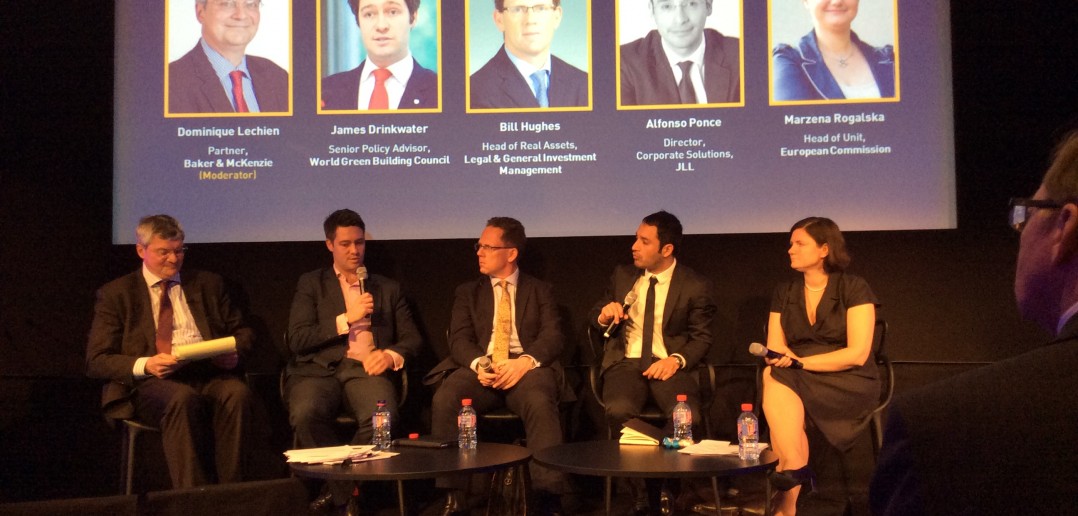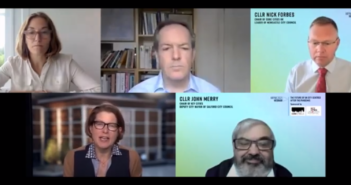14.30-15.30 Thursday, March 12
Sponsor: Baker and McKensie
A vast array of perspectives were combined in this session. Starting with occupiers.
- Alfonso Ponce, JLL: Occupiers are driving the green movement more than landlords. Landlords do what they must. We have seen an evolution from BREAM which was first in this space in the late 1980s. We have moved from materials and components to buildings. We used to use proxies that relate to carbon emissions but now we are more able to measure building performance and carbon footprint. There still remains a gap from building construction cost minimization to life cycle performance. The hard thing to do is measure productivity. There is a new rating system called Wellness by Delos, provides a broader perspective on the building environment and impact on the occupier.
- James Drinkwater, Sr. Building Advisor, World Green Building Council: There is a progression in measuring and benchmarking allows comparability and we are still not very standardized. He agreed that measuring productivity is the key and how do you measure that. There is HR data but it only measures sick days and things not that directly related to productivity.
- Bill Hughes, Legal & General Real Assets: As an investor in real estate it is essential we align our buildings to what occupiers want. The real estate sector is still learning how to capture data that is useful and comparable. I see ill-informed activities and behaviors. Many owners don’t understand how to use technology now available or even installed. The translation piece is missing and landlords think they are running buildings well but they are not.
- Alfred Ponce: You can have a good building but manage it poorly. Technology is not useful if you don’t know how to use it.
- Marzena Rogalska, European Union, Head of Unit: We try and spread the word on standard and facts. The EU has been important in setting up regulation and disclosure. We still lag on existing buildings. We focus more on new buildings and we will never get there if we don’t measure existing buildings. We also need to focus more on air quality and the health of occupants and their well-being. We are publishing materials on major products, systems and comparable standards.
- Alfred Ponce asked what is the challenge in measuring by different standards?
- Marzena Rogalska: Climates vary so it is hard to compare. We don’t always know what we want to regulate or how to measure costs and benefits. There is a lot of work remaining to be done.
- Dominique Lechien: An investor will no longer invest unless they know something about how a building measures on some sustainable standards. We are the front runners but we’d prefer a market based system, reality based.
- Bill Hughes: We have had three significant investors come to us because they know we are at the vanguard of sustainability. We also have tenants come to us because they know we hold high standards for sustainability. We have too many standards out there. We prefer and are promoting voluntary sustainability. A market driven approach is best.
- Dominique Lechien: We have one more measure but at a much higher level, starting with 16 countries, mostly in Europe. It is an index of sustainability by country and other groups. Does not the EU believe the industry should do this without so much regulation?
- Marzena Rogalska: We are reviewing everything and looking at the interaction of construction regulation versus results. We’d like the EU standards to be used more globally. That would help standardization.
Everyone agreed life cycle costing will move the market in the right direction, versus up front cost minimization. One journal providing resources is the journal of sustainable real estate. It has cases and studies on the economics of sustainable strategies.
 Norm Miller is a Professor of Real Estate at the University of San Diego at the Burnham-Moores Center. He is Editor of the Journal of Sustainable Real Estate, which he founded in 2009. He was at the University of Cincinnati for many years where he was Academic Director and the founder of the real estate center. He has worked extensively with various trade associations and is a sought after speaker on commercial real estate trends.
Norm Miller is a Professor of Real Estate at the University of San Diego at the Burnham-Moores Center. He is Editor of the Journal of Sustainable Real Estate, which he founded in 2009. He was at the University of Cincinnati for many years where he was Academic Director and the founder of the real estate center. He has worked extensively with various trade associations and is a sought after speaker on commercial real estate trends.



